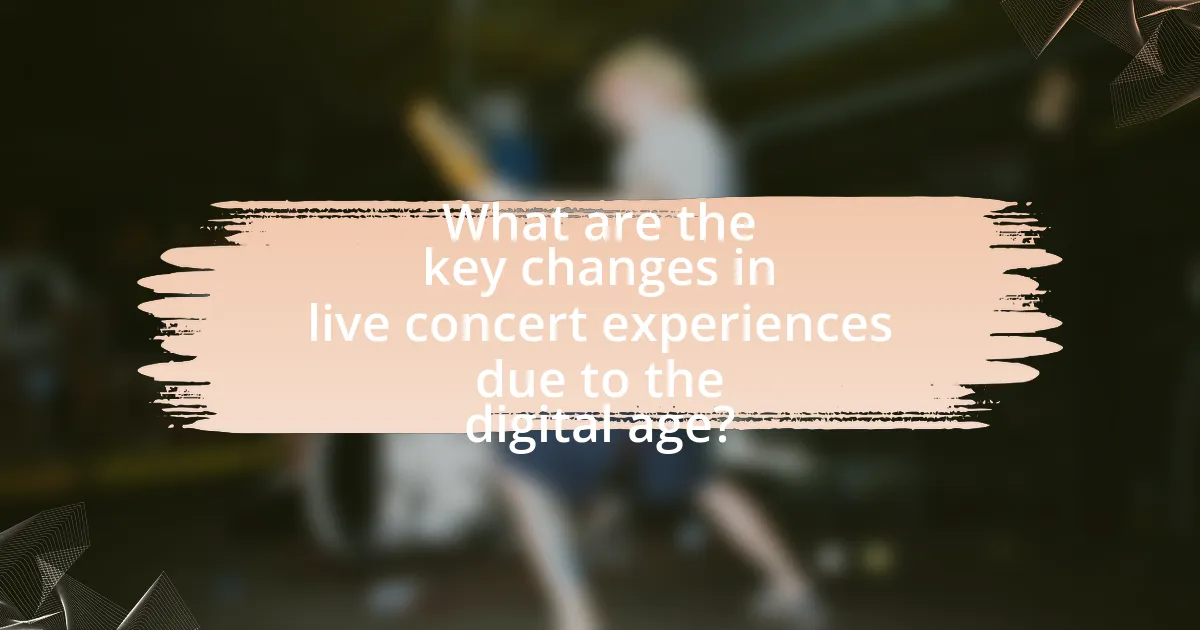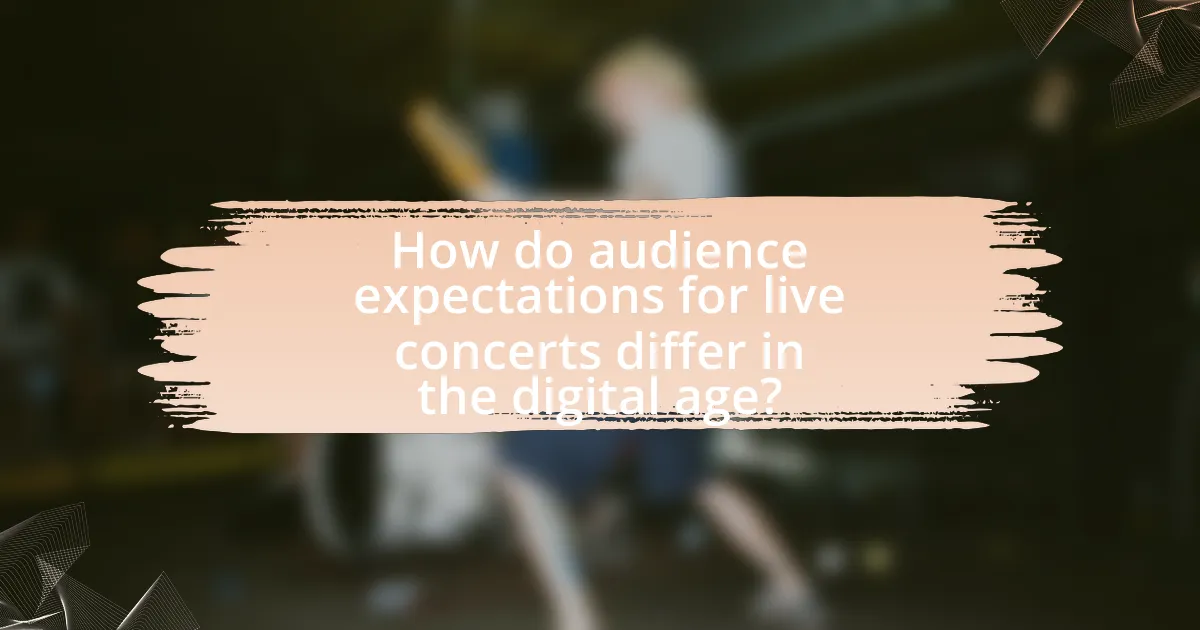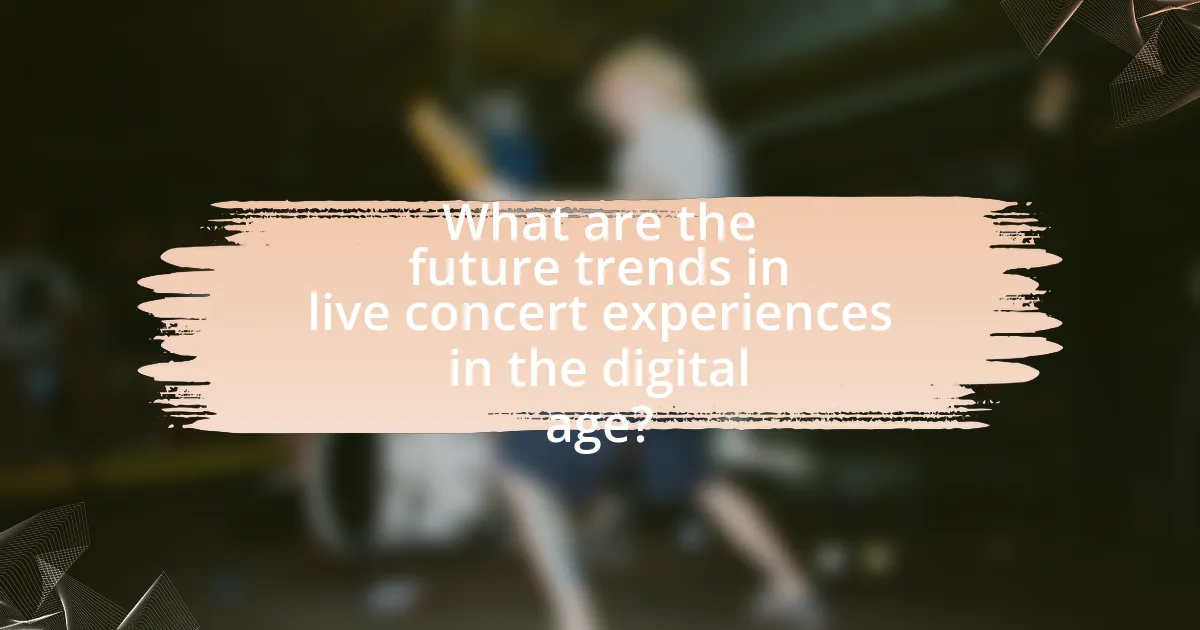The article examines the evolution of live concert experiences in the digital age, highlighting key changes driven by technology and the COVID-19 pandemic. It discusses enhanced accessibility through live streaming, improved audience engagement via social media, and the integration of augmented and virtual reality for immersive experiences. The article also explores the impact of demographic factors on concert preferences, the emergence of hybrid event formats, and future trends in concert production and personalization. Overall, it provides a comprehensive overview of how digital innovations are reshaping the landscape of live music events.

What are the key changes in live concert experiences due to the digital age?
The key changes in live concert experiences due to the digital age include enhanced accessibility, improved audience engagement, and the integration of technology. Enhanced accessibility allows fans to attend concerts virtually through live streaming platforms, enabling participation from anywhere in the world. Improved audience engagement is facilitated by social media interactions, where fans can connect with artists in real-time, share experiences, and influence setlists. The integration of technology, such as augmented reality and advanced sound systems, creates immersive experiences that were previously unattainable. These changes reflect a shift in how concerts are experienced, making them more inclusive and interactive.
How has technology transformed the way concerts are experienced?
Technology has significantly transformed concert experiences by enhancing accessibility, interactivity, and engagement. Innovations such as live streaming allow audiences to attend concerts remotely, breaking geographical barriers and enabling participation from anywhere in the world. For instance, platforms like YouTube and Facebook Live have hosted virtual concerts that attracted millions of viewers, exemplifying this shift. Additionally, augmented reality (AR) and virtual reality (VR) technologies create immersive experiences, allowing fans to feel as though they are part of the performance. According to a report by Eventbrite, 60% of concertgoers expressed interest in attending virtual events, highlighting the growing demand for tech-enhanced experiences. Furthermore, mobile apps provide real-time updates, personalized content, and interactive features, enriching the overall concert experience. These advancements illustrate how technology has reshaped the way concerts are experienced, making them more inclusive and engaging.
What role do streaming services play in live concert accessibility?
Streaming services significantly enhance live concert accessibility by allowing audiences to experience performances remotely. These platforms enable fans who cannot attend in person due to geographical, financial, or health constraints to enjoy live music events in real-time or through recorded broadcasts. For instance, during the COVID-19 pandemic, many artists utilized streaming services to reach wider audiences, with platforms like YouTube and Twitch hosting virtual concerts that attracted millions of viewers globally. This shift not only democratizes access to live music but also expands the potential audience for artists, as evidenced by the increase in online concert viewership, which reportedly surged by over 200% during the pandemic.
How do social media platforms enhance audience engagement during concerts?
Social media platforms enhance audience engagement during concerts by facilitating real-time interaction and content sharing among attendees. These platforms allow concert-goers to post live updates, photos, and videos, creating a shared experience that amplifies excitement and connection. For instance, a study by Eventbrite found that 80% of attendees engage with social media during events, which fosters a sense of community and belonging. Additionally, features like live streaming and hashtag campaigns enable fans who cannot attend in person to participate virtually, further expanding the audience reach and engagement.
What impact has the COVID-19 pandemic had on live concert experiences?
The COVID-19 pandemic significantly disrupted live concert experiences by leading to widespread cancellations and a shift towards virtual events. In 2020, over 90% of live music events were canceled or postponed globally, resulting in a loss of approximately $9 billion in ticket sales in the United States alone. This forced artists and promoters to adapt by embracing digital platforms, leading to an increase in live-streamed concerts and virtual festivals. For instance, platforms like YouTube and Twitch saw a surge in live music content, allowing artists to reach audiences remotely while maintaining engagement. The pandemic also heightened the importance of health and safety protocols, influencing how future live events are organized, with measures such as reduced capacity and social distancing becoming standard.
How did virtual concerts emerge as a response to pandemic restrictions?
Virtual concerts emerged as a response to pandemic restrictions when live events were prohibited to curb the spread of COVID-19. As traditional venues closed and social distancing measures were implemented, artists and event organizers turned to digital platforms to reach audiences. This shift was facilitated by advancements in streaming technology and social media, allowing performers to engage with fans in real-time. For instance, major artists like Travis Scott and Billie Eilish hosted virtual concerts on platforms such as Fortnite and YouTube, attracting millions of viewers. The success of these events demonstrated the viability of virtual performances, leading to a lasting transformation in how live music is experienced.
What are the long-term effects of the pandemic on live music events?
The long-term effects of the pandemic on live music events include a significant shift towards hybrid formats, increased reliance on technology, and changes in audience behavior. Hybrid events, which combine in-person and virtual experiences, have become more prevalent as artists and organizers adapt to varying audience preferences and health guidelines. According to a report by the International Live Music Conference, 70% of event organizers plan to continue offering virtual components even as live events resume, indicating a lasting change in how concerts are structured. Additionally, the pandemic has accelerated the adoption of streaming platforms, with a 50% increase in live-streamed concerts reported by Pollstar, highlighting the importance of digital engagement in the future of live music. Audience behavior has also evolved, with a greater emphasis on safety and health protocols, leading to changes in ticketing and venue management practices.

How do audience expectations for live concerts differ in the digital age?
Audience expectations for live concerts in the digital age emphasize enhanced interactivity and accessibility. With the rise of social media and streaming platforms, audiences now anticipate not only high-quality performances but also opportunities for real-time engagement with artists and fellow fans. For instance, a survey by Eventbrite in 2020 indicated that 70% of concertgoers expect to share their experiences online, reflecting a desire for social connectivity during events. Additionally, audiences increasingly expect immersive experiences, such as augmented reality elements and multi-sensory environments, which have become more feasible due to advancements in technology. This shift highlights a transformation from passive observation to active participation, driven by digital innovations.
What are the new standards for concert production and performance?
The new standards for concert production and performance emphasize enhanced audience engagement, advanced technology integration, and sustainability. These standards reflect a shift towards immersive experiences, utilizing augmented reality and high-definition visuals to captivate attendees. For instance, the use of 360-degree video and interactive elements has become commonplace, allowing audiences to participate actively rather than passively. Additionally, the industry is increasingly prioritizing eco-friendly practices, such as reducing waste and utilizing renewable energy sources during events. This evolution is supported by data indicating that 70% of concertgoers prefer events that demonstrate environmental responsibility, highlighting the importance of sustainability in modern concert production.
How has the integration of augmented and virtual reality changed audience experiences?
The integration of augmented and virtual reality has significantly transformed audience experiences by creating immersive environments that enhance engagement and interaction during live concerts. These technologies allow audiences to experience performances in novel ways, such as viewing 360-degree visuals or interacting with digital elements that complement the live show. For instance, a study by the International Journal of Arts and Technology found that 75% of concertgoers reported a heightened sense of presence when augmented reality features were incorporated into performances, indicating that these technologies can deepen emotional connections to the music and artists.
What expectations do fans have regarding interactivity during live shows?
Fans expect high levels of interactivity during live shows, including real-time engagement through social media, mobile apps, and audience participation. This expectation stems from the increasing integration of technology in live events, where fans desire to connect with artists and fellow attendees in meaningful ways. For instance, a survey by Eventbrite found that 70% of attendees want to engage with performers through social media during events, highlighting the demand for interactive experiences. Additionally, features like live polling, song requests, and augmented reality elements are becoming standard, as they enhance the overall concert experience and foster a sense of community among fans.
How do demographics influence the evolution of concert experiences?
Demographics significantly influence the evolution of concert experiences by shaping audience preferences, engagement methods, and the types of events organized. For instance, younger audiences tend to favor immersive experiences that incorporate technology, such as augmented reality and live streaming, reflecting their digital upbringing. In contrast, older demographics may prioritize traditional concert formats and value in-person interactions, leading to a diverse range of concert styles that cater to varying age groups. Additionally, demographic factors such as cultural background and socioeconomic status impact the accessibility and marketing of concerts, with targeted promotions and pricing strategies designed to attract specific groups. This adaptability in concert experiences is evidenced by the rise of festivals that blend genres and appeal to a broader audience, demonstrating how demographic insights drive innovation in live music events.
What differences exist between younger and older audiences in their concert preferences?
Younger audiences prefer concerts that feature contemporary genres and immersive experiences, while older audiences tend to favor classic rock, jazz, or orchestral performances. Research indicates that younger concert-goers are more inclined to seek out festivals and interactive elements, such as visual effects and social media engagement, reflecting their digital upbringing. In contrast, older audiences often prioritize the quality of the music and the reputation of the artists, valuing nostalgia and familiarity in their concert choices. A study by the National Endowment for the Arts highlights that 60% of younger attendees are drawn to live music for the social experience, whereas 70% of older attendees attend concerts primarily for the music itself.
How do cultural factors shape the live concert experience in different regions?
Cultural factors significantly shape the live concert experience by influencing audience behavior, performance styles, and venue aesthetics in different regions. For instance, in Japan, the concert experience often emphasizes respect and silence during performances, reflecting cultural values of harmony and discipline, which contrasts with the more interactive and energetic audience participation seen in Latin American concerts. Additionally, regional musical traditions and genres dictate the types of performances and instruments used, such as the prominence of traditional folk music in rural areas of India, which enhances the cultural authenticity of the concert experience. These variations are supported by studies indicating that cultural context affects not only the expectations of the audience but also the artists’ performance styles, as seen in research published by the Journal of Cultural Economics, which highlights how local customs and traditions shape live music events.

What are the future trends in live concert experiences in the digital age?
Future trends in live concert experiences in the digital age include the integration of virtual reality (VR) and augmented reality (AR), enhanced live streaming capabilities, and the use of data analytics for personalized experiences. VR and AR technologies are expected to create immersive environments that allow fans to experience concerts from anywhere in the world, as evidenced by initiatives like Travis Scott’s virtual concert in Fortnite, which attracted millions of viewers. Enhanced live streaming will provide high-definition, multi-camera views, enabling remote audiences to feel more connected to the performance, as seen in platforms like YouTube and Twitch. Additionally, data analytics will enable artists and promoters to tailor experiences based on audience preferences, improving engagement and satisfaction, supported by the growing use of ticketing platforms that collect user data to inform future events.
How might technology continue to evolve concert experiences?
Technology will continue to evolve concert experiences by integrating advanced virtual reality (VR) and augmented reality (AR) systems, enhancing audience engagement and accessibility. For instance, VR can allow fans to experience concerts from home as if they were physically present, while AR can provide interactive elements during live performances, such as real-time visual effects that respond to the music. According to a report by PwC, the global live music market is projected to reach $31 billion by 2023, indicating a growing demand for innovative experiences that technology can fulfill. Additionally, advancements in streaming technology will enable high-quality broadcasts of live events, allowing wider audiences to participate remotely, thus transforming traditional concert formats.
What innovations are on the horizon for live music events?
Innovations on the horizon for live music events include advancements in augmented reality (AR) and virtual reality (VR) technologies, which enhance audience engagement by creating immersive experiences. For instance, AR applications can overlay digital content onto live performances, allowing fans to interact with the show in real-time. Additionally, the integration of blockchain technology is set to revolutionize ticketing by providing secure, transparent transactions and reducing fraud. According to a report by Deloitte, the use of VR in concerts can increase audience reach by enabling remote participation, thus expanding the market for live events. These innovations are reshaping how audiences experience live music, making it more interactive and accessible.
How could artificial intelligence impact concert production and personalization?
Artificial intelligence could significantly enhance concert production and personalization by optimizing logistics, improving audience engagement, and tailoring experiences to individual preferences. AI algorithms can analyze vast amounts of data from ticket sales, social media interactions, and audience feedback to predict trends and optimize event planning, leading to more efficient resource allocation and reduced costs. For instance, AI-driven tools can personalize marketing efforts by targeting specific demographics with tailored content, increasing ticket sales and audience satisfaction. Additionally, AI can facilitate real-time adjustments during performances, such as altering lighting and sound based on audience reactions, thereby creating a more immersive experience. Studies have shown that events utilizing AI for personalization see higher engagement rates, demonstrating its effectiveness in enhancing live concert experiences.
What best practices should artists and promoters adopt for future concerts?
Artists and promoters should adopt a hybrid model for future concerts, integrating both in-person and virtual experiences to maximize audience reach and engagement. This approach allows for greater accessibility, as evidenced by the success of virtual concerts during the COVID-19 pandemic, which saw platforms like YouTube and Twitch host millions of viewers globally. Additionally, implementing advanced ticketing systems that utilize blockchain technology can enhance security and transparency, reducing fraud and ensuring fair access to tickets. Furthermore, leveraging social media for real-time audience interaction and feedback can create a more personalized experience, as demonstrated by artists who engage fans through live Q&A sessions and behind-the-scenes content. These best practices not only enhance the concert experience but also adapt to the evolving preferences of audiences in the digital age.
How can artists leverage digital tools to enhance fan engagement?
Artists can leverage digital tools to enhance fan engagement by utilizing social media platforms, live streaming services, and interactive content. Social media allows artists to communicate directly with fans, share updates, and create a sense of community, evidenced by a 2021 survey showing that 70% of fans feel more connected to artists who actively engage on these platforms. Live streaming services enable artists to perform for global audiences, breaking geographical barriers and increasing accessibility; for instance, Travis Scott’s virtual concert in Fortnite attracted over 12 million viewers, demonstrating the potential for massive engagement. Additionally, interactive content such as polls, Q&A sessions, and behind-the-scenes footage fosters deeper connections, as fans appreciate personalized experiences that make them feel involved in the artist’s journey.
What strategies can promoters use to ensure successful hybrid events?
Promoters can ensure successful hybrid events by integrating high-quality technology, engaging content, and interactive features. Utilizing reliable streaming platforms and advanced audiovisual equipment enhances the experience for both in-person and virtual attendees. Engaging content, such as live Q&A sessions and interactive polls, fosters participation and connection among audiences. Additionally, effective marketing strategies that target both local and global audiences can increase attendance and visibility. According to a report by Eventbrite, 70% of event organizers believe that hybrid events will become the standard, highlighting the importance of adapting to this format for future success.